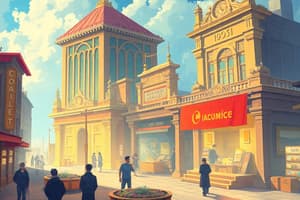Podcast
Questions and Answers
What does it mean to compete?
What does it mean to compete?
- To work toward a goal while attempting to defeat rivals (correct)
- To collaborate with others for a common goal
- To avoid confrontation and participate passively
- To work independently without any external influence
What is monopolistic competition?
What is monopolistic competition?
A market structure in which many sellers produce the same item but each producer sets its own price and quality.
Define a monopoly.
Define a monopoly.
A market that has a single supplier of a good or service.
What characterizes an oligopoly?
What characterizes an oligopoly?
What is pure competition?
What is pure competition?
What is sovereignty in a market context?
What is sovereignty in a market context?
When can monopolies form?
When can monopolies form?
What characterizes natural monopolies?
What characterizes natural monopolies?
What are technological monopolies?
What are technological monopolies?
What are government monopolies?
What are government monopolies?
What is consumer sovereignty like in a monopoly?
What is consumer sovereignty like in a monopoly?
How do oligopolies form?
How do oligopolies form?
What is the nature of competition in an oligopoly?
What is the nature of competition in an oligopoly?
Can the car industry be considered an oligopoly?
Can the car industry be considered an oligopoly?
What is consumer sovereignty in an oligopoly?
What is consumer sovereignty in an oligopoly?
What defines monopolistic competition?
What defines monopolistic competition?
What is consumer sovereignty like in monopolistic competition?
What is consumer sovereignty like in monopolistic competition?
What characterizes pure competition?
What characterizes pure competition?
Where is consumer sovereignty greatest?
Where is consumer sovereignty greatest?
Flashcards are hidden until you start studying
Study Notes
Market Structures Overview
- Compete: Engaging in activities to achieve a goal while attempting to outperform rivals.
Types of Market Structures
-
Monopolistic Competition:
- Characterized by many sellers producing similar products.
- Each producer sets unique prices and quality without affecting the overall market.
-
Monopoly:
- A market controlled by a single supplier offering a good or service.
-
Oligopoly:
- A market structure with few businesses.
- Firms influence the market without complete control, often leading to limited competition.
-
Pure Competition:
- Features numerous sellers offering identical products.
- Free flow of information and unrestricted market entry and exit.
Consumer Sovereignty and Market Influence
-
Sovereignty: Refers to the controlling influence consumers have in a market.
-
In monopolistic competition, consumer choices are more varied due to lower entry barriers, requiring producers to offer desirable goods.
Formation of Monopolies
-
Monopolies can develop when:
- Close substitutes are unavailable for goods.
- Barriers hinder new producers from entering the market.
-
Natural Monopolies:
- Arise when a single producer efficiently meets total market demand due to high production costs.
- Common in utilities, e.g., electricity providers.
-
Technological Monopolies:
- Occur when one producer dominates a production method, often protected by patents.
-
Government Monopolies:
- Established by the government, where it is the sole provider in a market; other competitors are legally excluded.
Consumer Experience in Different Market Structures
-
In monopolies, limited consumer sovereignty leads to fewer choices and stable prices due to lack of competition.
-
Oligopolies restrict consumer sovereignty, offering limited options typically based on brand loyalty, resulting in higher prices and reduced overall output.
Characteristics of Competitive Structures
-
Monopolistic Competition:
- Producers set prices within a similar range to competitors, offering differentiated products with few barriers to entry.
-
Pure Competition:
- Producers provide identical goods, with no price control; market dynamics are driven by supply and demand.
- Consumers can impact the market through price-driven decisions, promoting lower prices due to competition.
Studying That Suits You
Use AI to generate personalized quizzes and flashcards to suit your learning preferences.




